Report

Why we should align with the Sustainable Development Goals (SDGs) 2030
The SDGs 2030 are global goals, locally owned by 193 countries across the world, including India (see Figure 1). Anchored by the United Nations, the SDGs offer a globally accepted language and uniform metrics for all countries against which to measure and compare progress. The shared agenda also allows national and subnational stakeholders to work towards the same goals, regardless of their point of entry or operational scale.
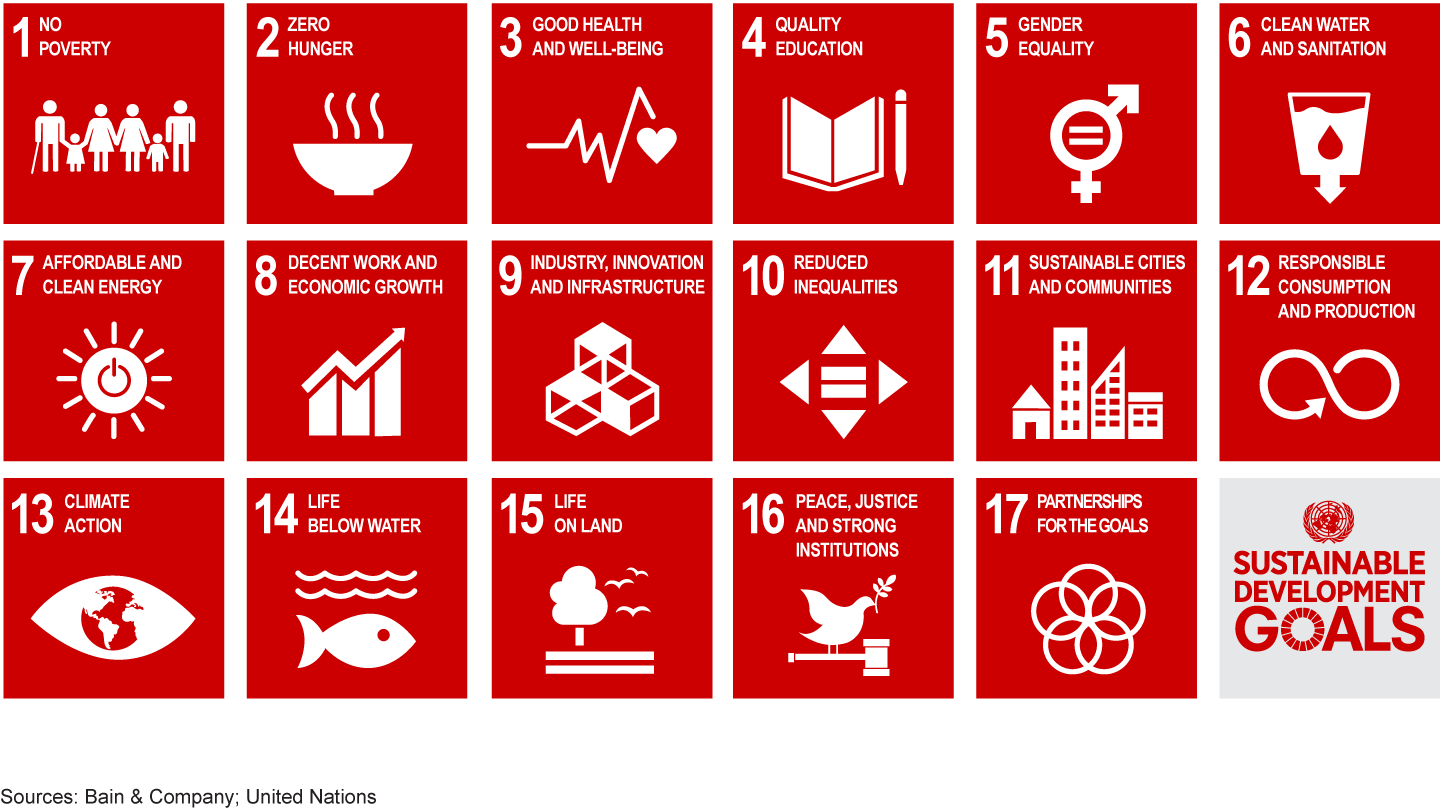
The SDGs advocate for bold, sustainable development that focuses on people, the planet, peace and prosperity. The SDGs identify 17 fields across 163 interconnected indicators and push for alignment and collaborative action among development stakeholders. The SDGs have high ambitions: elimination, not just reduction, of problems like poverty and malnutrition. The framework challenges India to redesign its development narrative to leave no one behind as it grows into an emerging world power.

Philanthropy In India: Time to Up Our Game
All philanthropists can participate in the field approach, regardless of the level or nature of their giving.
India’s philanthropic landscape: Current and desired role
India has had strong philanthropic momentum in the recent past. Focused efforts from government and active participation from civil society have helped the cause. However, it has substantial goals too, especially in the context of the government adopting the 2030 Agenda for Sustainable Development. This agenda includes the 17 SDGs, which set measurable and outcome-oriented objectives across the social, economic and environmental dimensions of sustainable development—by 2030.
The good news is that India’s stakeholders have adopted and committed to a focused approach towards the SDGs. The National Institute for Transforming India created an SDG India Index for rating states using 62 national indicators to capture 13 out of 17 SDG targets. Through an extensive mapping exercise, each SDG has been linked to nodal ministries, other concerned ministries, departments and centrally sponsored schemes to direct policies and resources towards specific targets. The civil society has unified in a movement called “Wada Na Todo Abhiyan,” (or, “Don’t break your promises”) whose aim is to ensure government accountability to the SDGs. Furthermore, Indian media has ensured that the SDGs remain a national priority. A recent study by the Brookings Institution found the Indian media has among the highest number of articles per year on the SDGs.
Social sector funds continue to grow in India
To put this agenda into action, social sector funding continues to increase contributions across the board. Overall, total social sector funds have grown at a rate of 11% over the past five years. While the government continues to be the largest contributor to social sector funding in India, hovering at about 6% of GDP, private philanthropy is expanding and has outpaced public funding growth.
Private domestic capital is leading the growth, fuelled by individual philanthropists’ passion
Despite a slowdown in foreign funding in recent years, private funding grew at a rate of 15% per year between FY2014 and FY2018, while public funding increased at a pace of about 10% per year (see Figure 2).
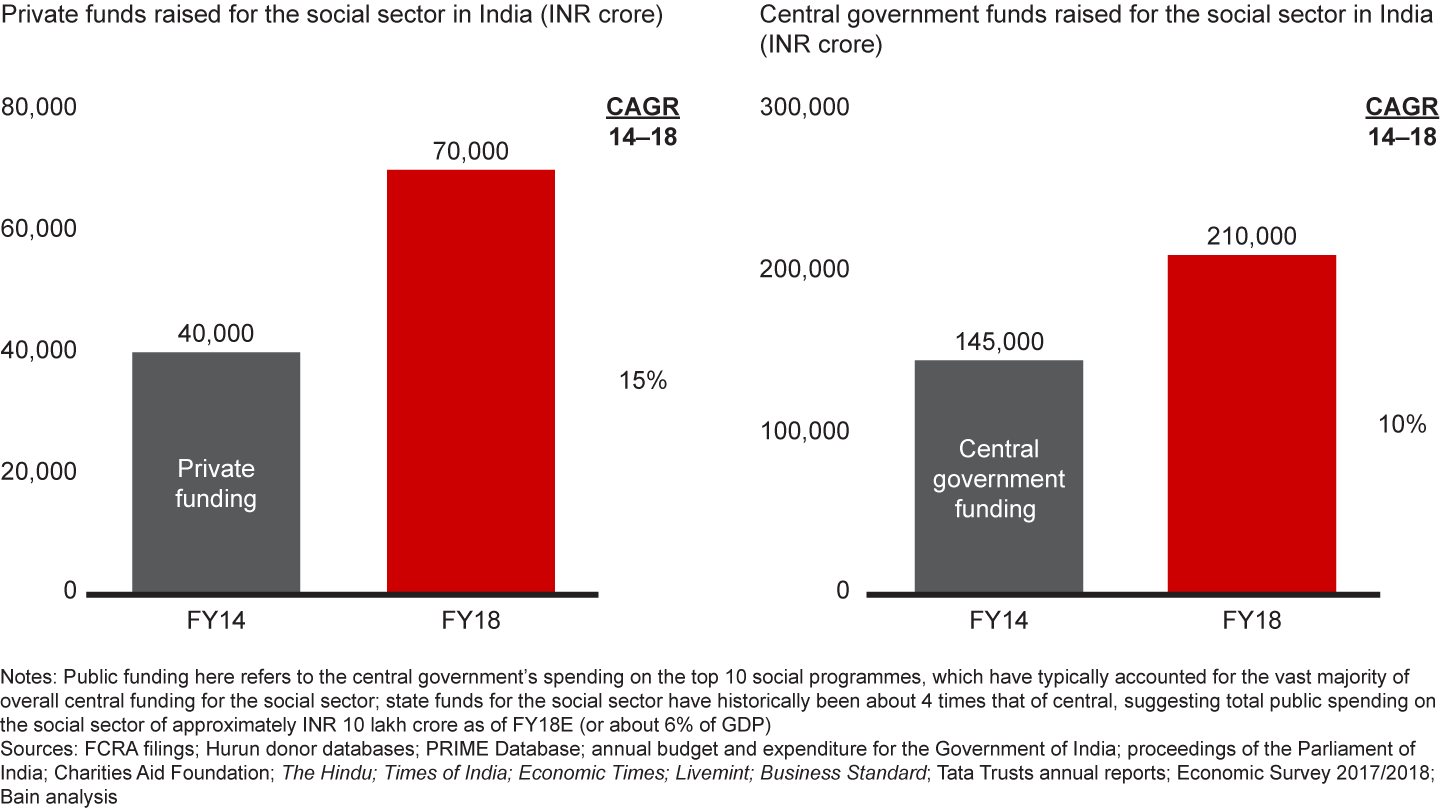
Foreign sources: Foreign contributions declined by about 40% (see Figure 3). This comes amid a government crackdown on non-governmental organisations (NGOs) for violation of the Foreign Contribution Regulation Act (FCRA) of 2010. According to data from the Ministry of Home Affairs, more than 13,000 NGO licences have been cancelled under the FCRA in the past three years, including approximately 4,800 in 2017 alone. NGOs need to comply with government regulations, including timely filing of annual returns and validation of bank accounts receiving foreign funds, to allow for a larger influx of foreign funds and thereby increase the social sector’s wallet size.
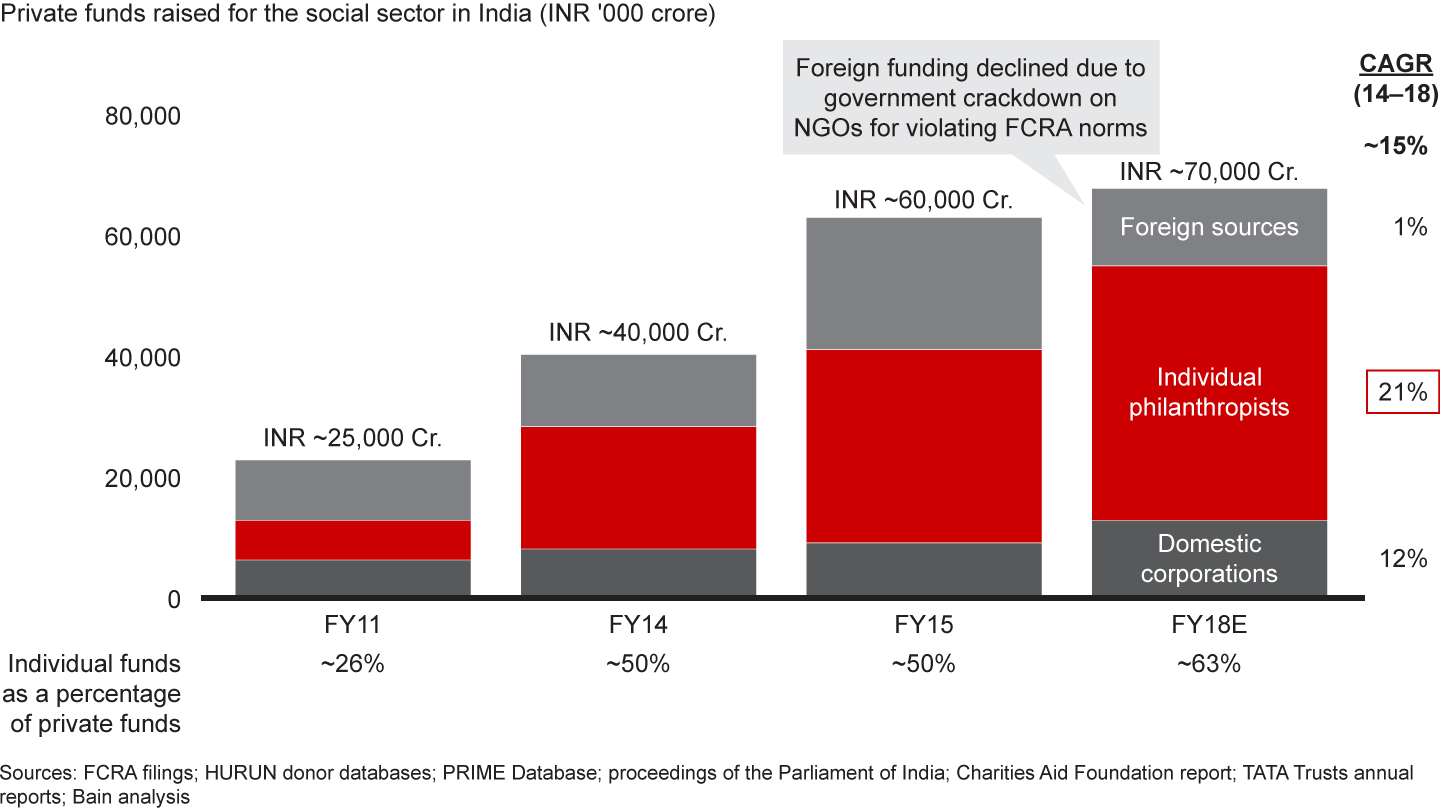
Domestic corporations: Corporate Social Responsibility (CSR) budget outlays of the domestic corporations and contributions of corporate charitable trusts, combined, have grown at a rate of 12% between FY2014 and FY2018, and they contributed approximately INR 13,000 crore to social sector funding in FY2018.
Individual philanthropists: Philanthropic funding from individuals remains the brightest spot. The segment has seen strong growth—21% per year in the past five years—and these individuals currently contribute about 60% of the total private funding, estimated at INR 43,000 crore. A significant portion of this comes from a few established figures who continue to lead individual giving, as they have in the past (see Figure 4).

Strong philanthropic momentum has resulted in encouraging results in some crucial development indicators
Increased spending from the government in cleanliness-, health- and housing-related schemes, along with active participation from private individuals and organisations, led to encouraging results in some of the crucial development indicators under the SDGs, such as sanitation cover, infant mortality rate and access to housing in rural India (see Figure 5).
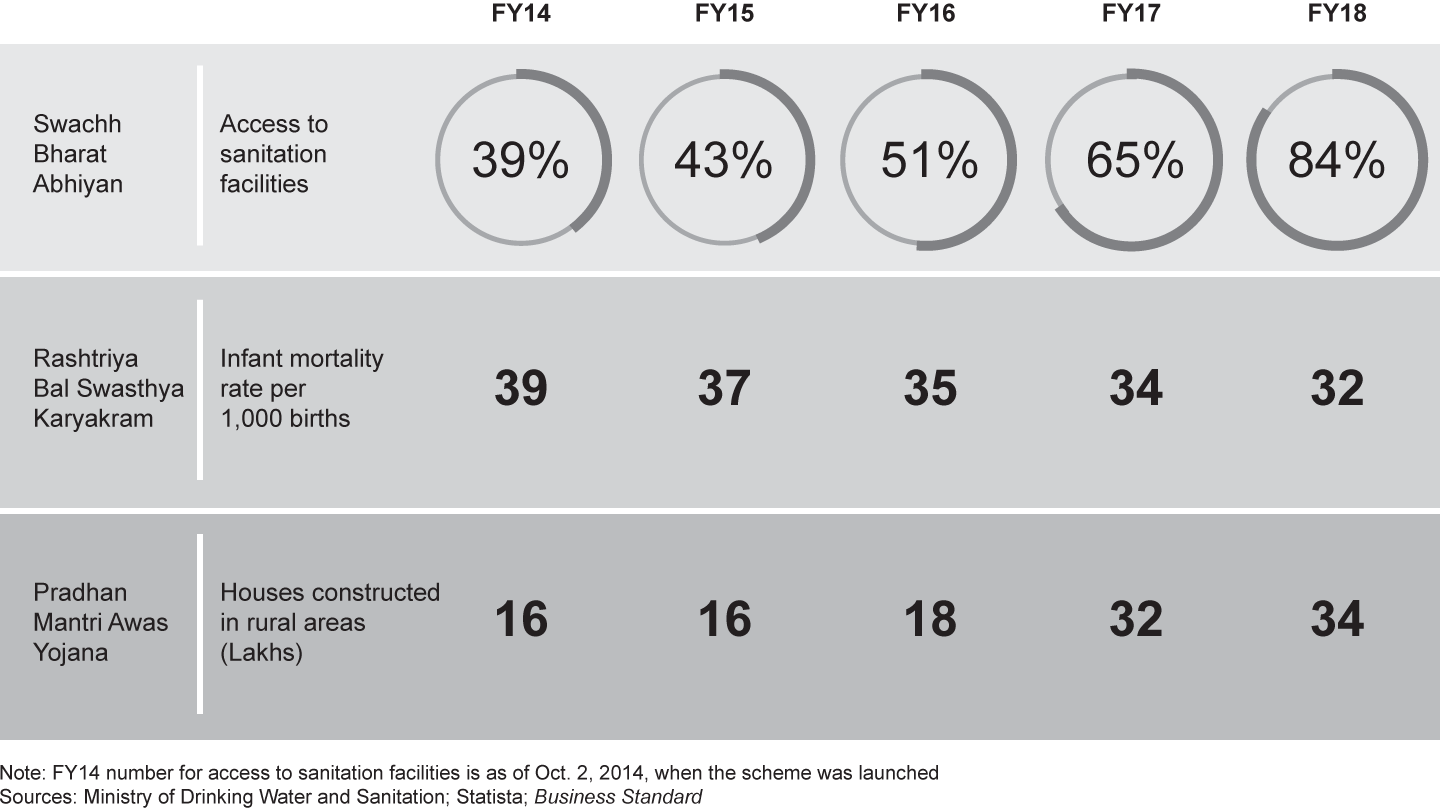
India’s economy today is robust and resilient, and it has the potential to deliver sustained growth. The Indian economy grew at an annualised 8.2% in the first quarter of FY2019, maintaining its position as the world’s fastest-growing major economy. Moreover, the World Bank estimates that India will be the fastest-growing economy at least until 2021. The cumulative wealth of India’s population may reach US $25 trillion by 2027. The number of Ultra High-Net-Worth Individuals (UHNIs), which we define as individuals with more than 25 crore in net worth, is expected to increase from about 62,000 in FY2011 to potentially about 330,000 by FY2022, reports Kotak Wealth Management. India is expected to add approximately 200 million working-age individuals to the population between 2013 and 2030—more than all major countries combined, according to Bain’s Macro Trends Group. According to our estimates, the high and upper-middle income segment is expected to double from one in four households in 2018 to one in two households by 2030.
The nation’s strong economic growth and rising high and upper-middle income segment indicate that there is further potential for growth in both domestic private and public contributions to social sector funding in the future.
However, to meet the SDGs, India needs social impact at scale to eradicate poverty and challenges affecting its poor and at-risk citizens
Economic growth alone won’t be enough to achieve India’s development goals. Estimates suggest that about 330 million Indians will remain in relative poverty (income of less than INR 10,000 per month) in 2050, even if the current growth rate is sustained (see Figure 6).
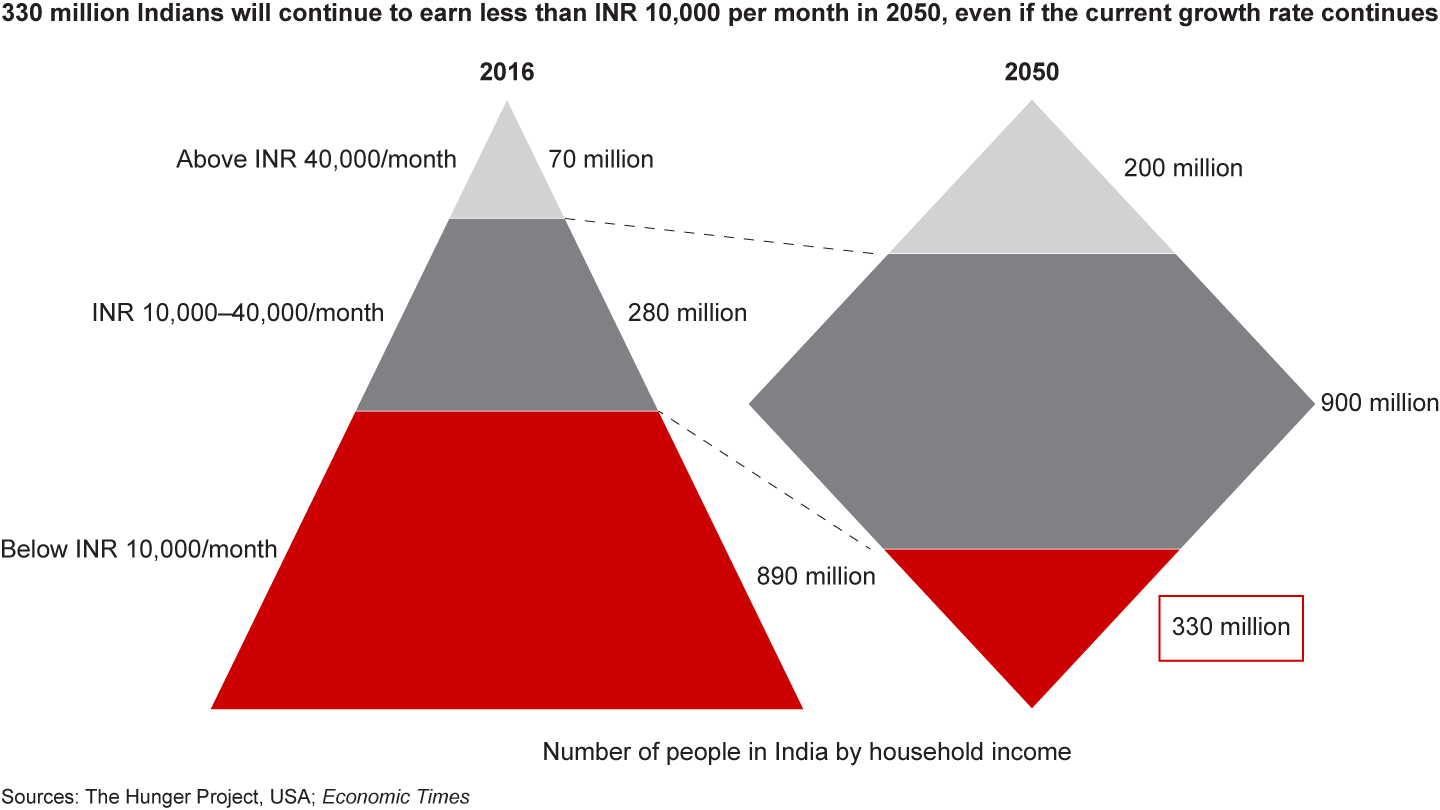
India has significant distance to cover on almost all development fronts. Its ranking on global development indicators like the Human Development Index (HDI) and the SDG index hasn’t improved substantially in recent years. The country ranked 130 on the HDI in 2018, the same ranking as in 2014, and 112 on the SDG index in 2018, a two-point drop since the index was first published in 2016 (see Figure 7). The extent of the issue is evident from the fact that India accounts for more than 20% of the absolute world performance gap in 10 of the 17 SDGs and more than 10% of the gap in another 6 of 17 SDGs (see Figure 8). Given India’s high contribution to the world performance gap, the country will play a critical role in the world’s ability to deliver on the SDGs by 2030.
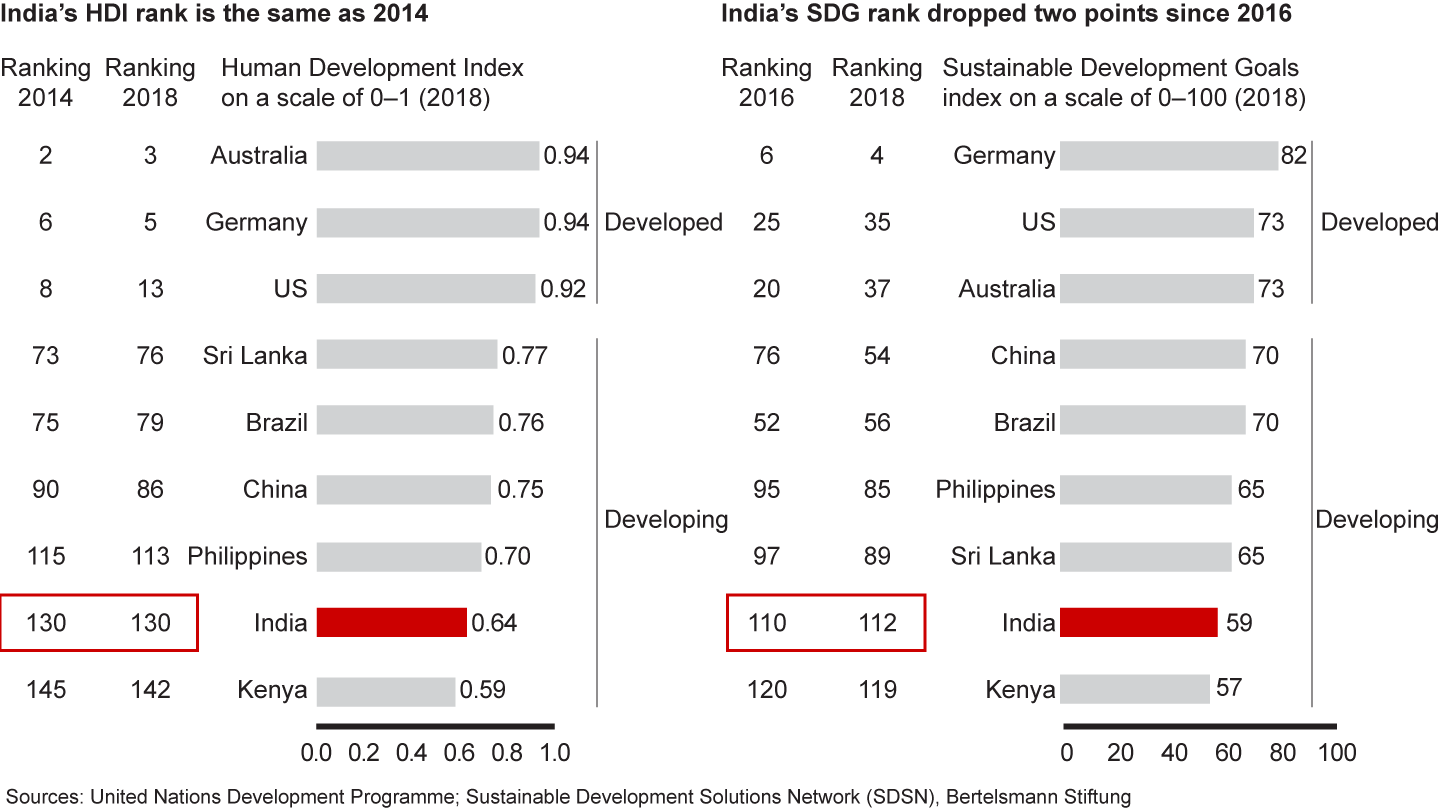
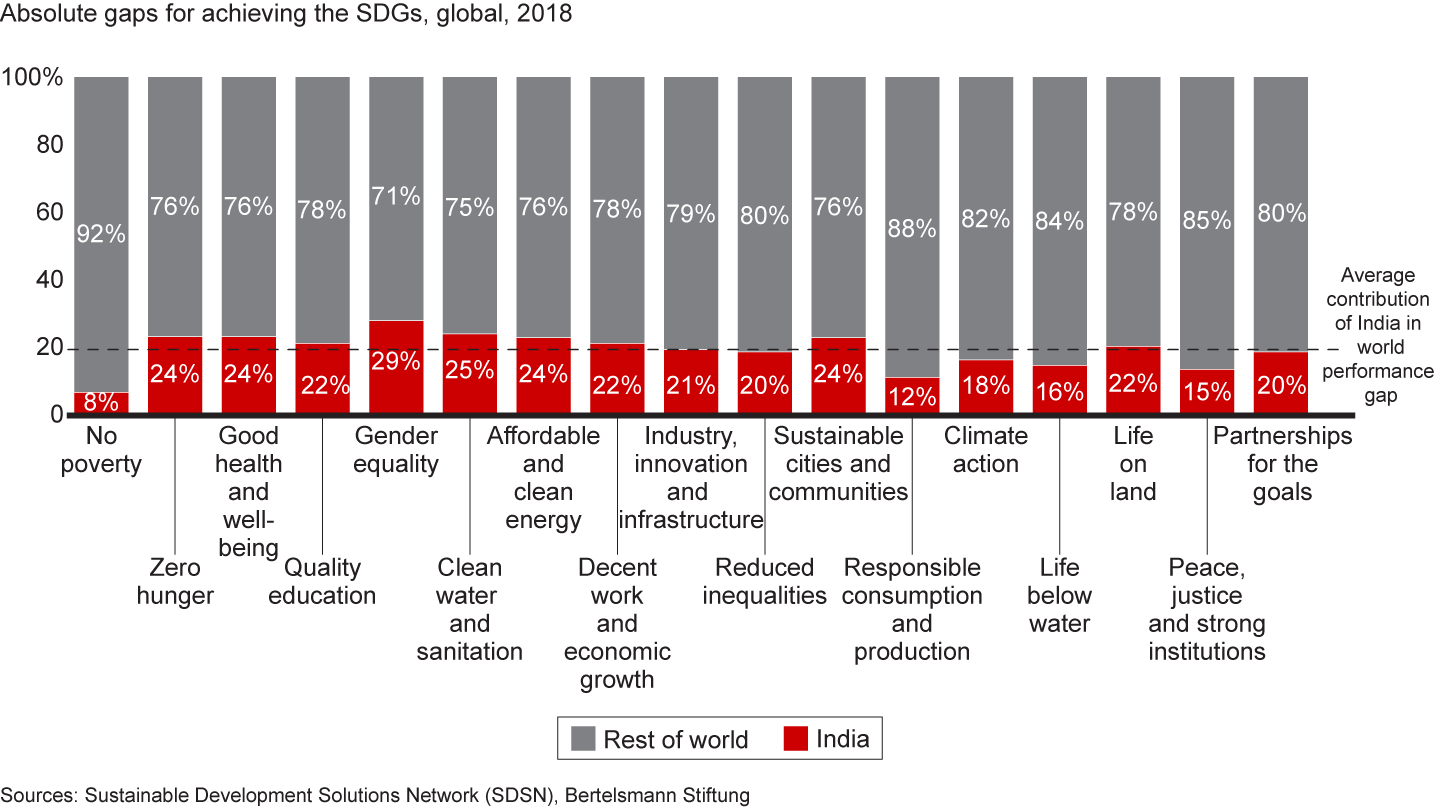
Furthermore, a study conducted by the Central Bureau of Investigation revealed, as reported in the Indian Express, that India has at least 31 lakh NGOs—more than double the number of schools and 250 times the number of government hospitals in the country, suggesting that efforts are fragmented. Another study, conducted among a sample set of donors during the course of writing the 2018 India Philanthropy Report, revealed that only 40% of respondents planned to “increase the scale and impact of their giving” as their philanthropic goalpost for 2020. Furthermore, only half of the respondents chose to answer a question asking them to rate the impact of their current giving to the end beneficiary. Among those who did respond, their average rating was 5 out of 10, demonstrating the need to adopt an outcome-oriented lens to philanthropy to keep results at the centre of giving.
These statistics indicate that outcome-oriented and collaborative efforts in a few transformative engagements will be key to unlocking innovations and creating social impact at scale in India.
India’s social sector requires significant additional funding to achieve the SDGs; ultra-rich individuals and several corporations can give more
The SDGs require sizable outlays, given the size of India’s population and the history of underfunding in social areas. Estimates suggest that India needs an average of approximately INR 26 lakh crore in annual funding to fulfil even five of the SDGs by 2030 (zero hunger, good health and well-being, quality education, gender equality, and clean water and sanitation). Even in the most optimistic scenario—in which India sustains its current economic growth rate and its current funding growth rate, all philanthropic capital is channelled towards the SDGs, there is no leakage in deployment, and the funding required to meet the SDGs doesn’t increase—the nation will still face an annual funding gap of around INR 4.2 lakh crore (about $60 billion). Depending on how each of these factors evolve, the actual shortfall could be two to four times that amount. Therefore, it is critical that public social sector expenditure (central and state), the mainstay of the total funding, increases substantially.
At the same time, increased contributions from private philanthropy are needed to supplement public spending in two ways. First, private philanthropy can be a catalyst to increase government spending and cover the funding shortfall the nation is experiencing. Second, private philanthropy can help ensure timely and effective fund deployment, with greater accountability and monitoring. With a growing economy and rising wealth, the role of domestic private philanthropy becomes increasingly important, regardless of how foreign contributions evolve. Both domestic corporations and Indian UHNIs need to enhance the level and nature of their giving.
Domestic corporations: In line with the requirements of the Companies Act 2013, companies have been focusing on their CSR activities. While the CSR budget set aside by qualifying companies is in line with government norms of spending 2% of their three-year average net profit, the unspent budget remains a cause for concern. As much as 15% of the allocated budget was unspent in 2018. Although the utilisation trend is moving in the right direction—74% fund utilisation in FY2014 to 85% in FY2018—there is room to improve before we start allocating more of companies’ net profits to their CSR budget (see Figure 9).
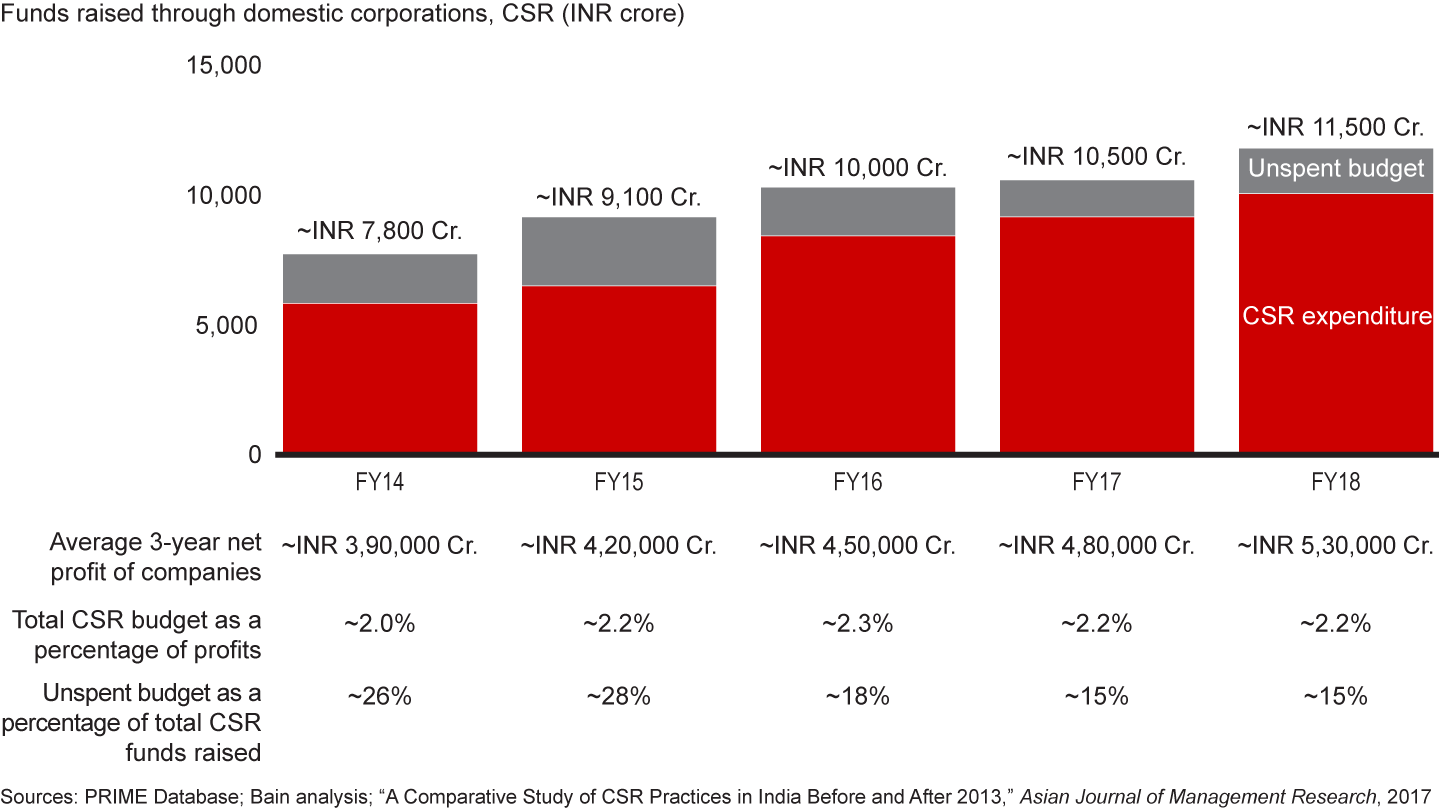
Individual philanthropists: Individual philanthropists accounted for about 60% of total private funding in FY2018 in India, compared with individual and bequest contributions of approximately 80% of the US’s total private funding in 2017, according to Giving USA. Clearly, there is room for growth.
A breakdown of contributions reveals that while large donations (INR 10 crore or more) by UHNIs compose 55% of individual philanthropist funding, about 80% of this figure results from Azim Premji’s donations to his philanthropic organisation, APPI. Take out that contribution across the years, and the segment has seen a 4% decrease (see Figure 10). This is particularly problematic, given that UHNI households have grown at a rate of 12% over the past five years and are expected to double in both volume and wealth from 1,60,600 households with INR 1,53,000 crore combined net worth in 2017 to 3,30,400 households with INR 3,52,000 crore combined net worth in 2022.
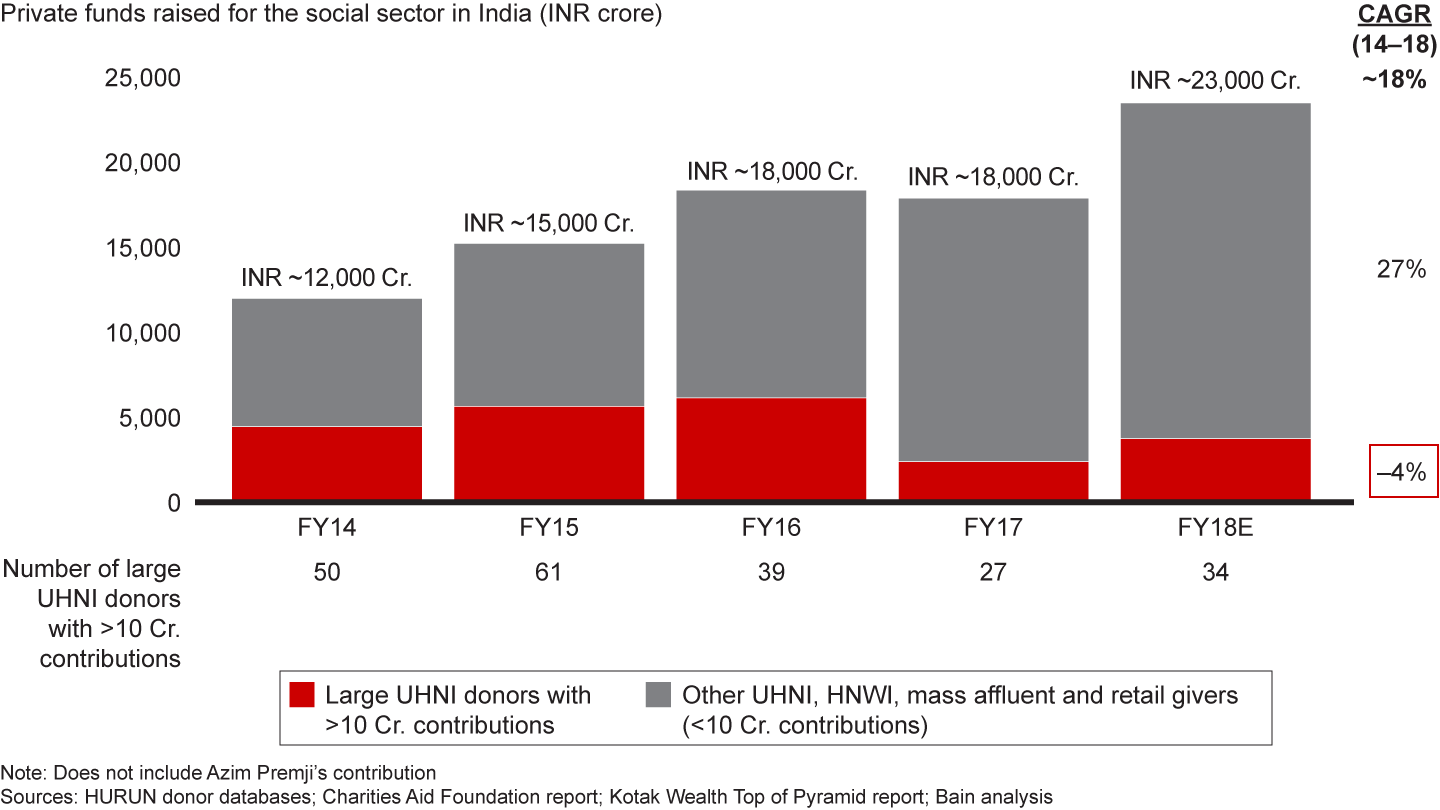
A benchmarking exercise of weighted average participation (the percentage of net worth contributed per year) compared with the US suggests an additional strategic giving potential of INR 40,000 to 60,000 crore from large UHNI donors alone. This increase, when compared with their current contribution of an estimated INR 23,000 crore, indicates a potential increase of 2.5 to 3.5 times the current level of giving (see Figure 11).
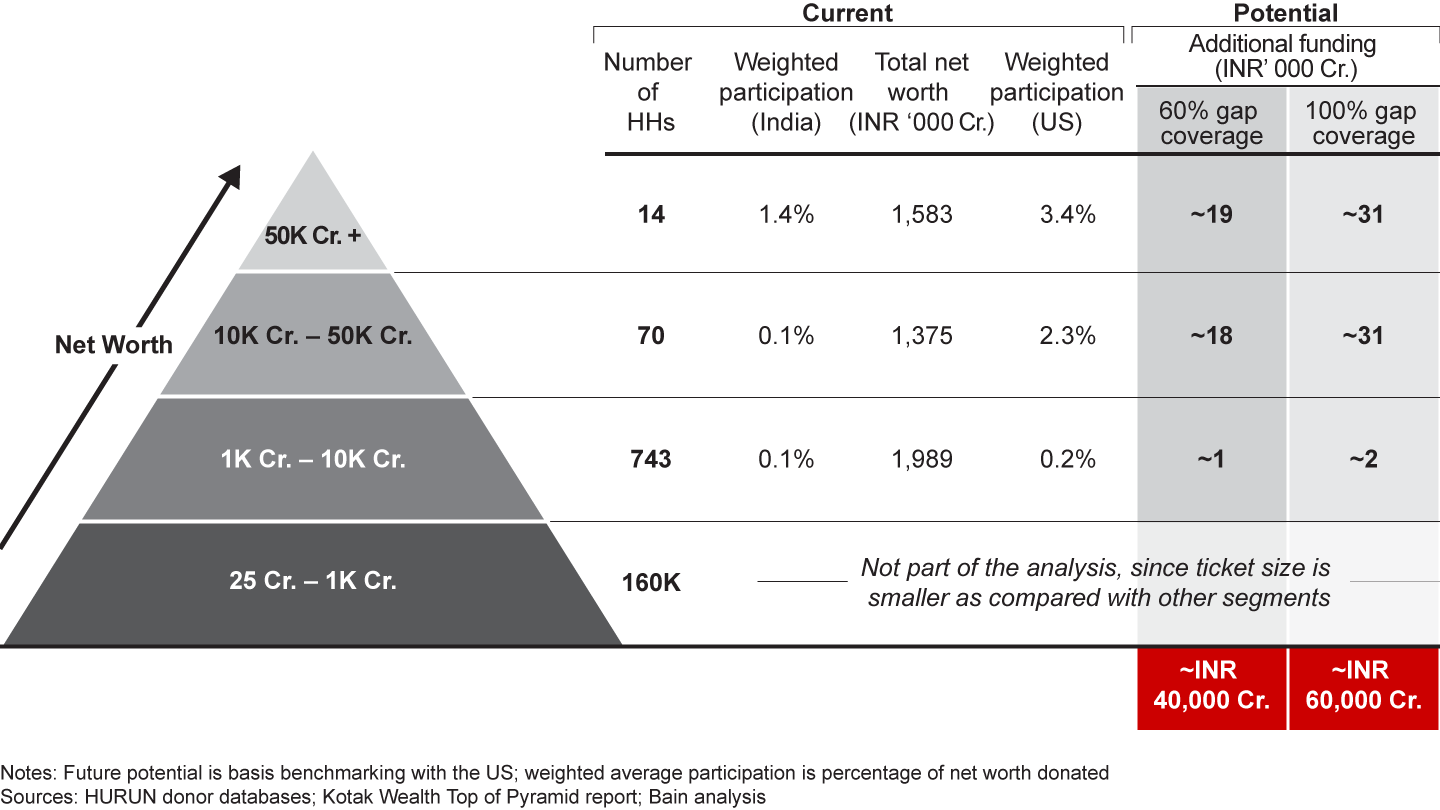
Furthermore, collaboration with the government will multiply the impact of every philanthropic rupee invested
While private philanthropic capital is growing and room exists for further acceleration, it might remain limited when compared with India’s overall funding needed to attain the SDGs. To maximise the impact of each rupee, private philanthropy should collaborate with the largest funder and scale partner in the landscape: the government. This collaboration has been tested in the past with a promising multiplier effect. Most often the multiplier translates into greater coverage when the government adopts a private philanthropy-funded programme and implements it at scale. This also frees risk capital that private philanthropists can invest in the next catalytic venture. What’s more, philanthropy-supported nonprofits may also provide technical and administrative services to improve the ways government funds are used.
While few examples exist of this partnership, there is a strong case for private philanthropists to partner with the government for results that would have been impossible as individual players. Actively seeking government partnership is a critical element of the field approach, which the next chapter advocates will help India achieve the SDGs.
Deploying the private philanthropic portfolio
In 2019, the world is asking philanthropists to work on large, complex problems that have been entrenched in a flawed system for centuries. This requires philanthropists to view the system as a whole, identify the root causes of issues and influence change at a fundamental level.
Over the past few decades, instances of successful systemic change have typically occurred by reaching “critical mass” in the field. Whether in the case of eradicating polio or starting civil rights movements, large-scale social change has invariably taken place when a critical mass of actors works towards a common vision. Philanthropy has the potential to play the role of a catalyst in that process.
To this end, philanthropists need to adopt a field approach. A field is a community of organisations and individuals working together to solve a common set of problems. The basis for this approach is that even the most effective or largest initiatives cannot achieve impact at scale if they remain isolated from other contributors in the field. The field approach considers all the stakeholders, identifies multiple areas of action, and coordinates them towards a specific goal. The aim is to generate significant momentum around the issue and create lasting change.
What makes the field approach particularly interesting is that it comes in different shapes and sizes and can be employed at multiple levels—from a country to a state or district. The SDGs lay out the largest fields and allow individuals to pick their part of the puzzle. For philanthropists considering how they can contribute, it is important to keep in mind the direction of the larger world and contribute in ways that will have the largest effect on the larger field.
The following four cases highlight the many ways in which philanthropists and other stakeholders have successfully adopted a field approach. The cases are not all funded by philanthropists, but they all demonstrate how the field approach works and how philanthropists could adopt a similar approach to their giving.
- Robert Wood Johnson Foundation’s tobacco control campaign
- The Roll Back Malaria Partnership to End Malaria
- The Bill and Melinda Gates Foundation’s Urban Sanitation Community of Practice
- 10to19 Dasra Adolescents Collaborative
Robert Wood Johnson Foundation’s tobacco control campaign
Since the early 1990s, the Robert Wood Johnson Foundation (RWJF) has played a vital role in tackling one of the largest causes of preventable death in the US: tobacco use.
The problem: When RWJF began its work in the tobacco control field, the steady progress that had been made against smoking since the mid-1950s (adult rates of smoking had dropped from 42.4% in 1965 to 25.5% in 1990) was slowing down considerably—the adult rate decreased only to 24.7% by 1997. But the smoking rate among high school students was on the rise, surging from 28.3% in 1991 to 36.5% in 1997.
The approach: RWJF knew that in order to get results, it had to influence public behaviours and mindsets at a large scale in a short amount of time. The foundation built on the work and momentum of advocates, researchers, philanthropists, health organisations, federal agencies and NGOs, and adopted strategies that amplified the reach of its message.
- One approach was to fund policy research and advocacy to make permanent structural changes to limit tobacco use. RWJF supported a Tobacco Policy Research and Evaluation Program whose research documented the harmful effects of smoking. This research-based evidence, compounded by the findings of existing studies funded by institutions like the American Cancer Society (ACS), formed the crux of RWJF’s advocacy efforts. It helped the foundation promote formal statewide and national coalitions to coordinate efforts focusing on policy and systems changes, such as higher tobacco excise taxes, smoke-free indoor air laws, access to cessation treatments and the federal regulation of tobacco. The resulting laws and regulations led to behaviour change and the eventual drop in the adult smoking rate to 19.7% and the rate among high school students to 20% in 2007.
- RWJF also aimed to influence social attitudes and norms. In 1995, it collaborated with the ACS, the American Health Association, the Annie E. Casey Foundation and others to create the Campaign for Tobacco-Free Kids. One of the campaign’s primary objectives was to educate the public and broaden public support to reduce youth tobacco use. To achieve this mission, RWJF supported initiatives to reduce the portrayal of smoking in movies, on television and in mass-market advertising and conducted targeted, evidence-based public awareness campaigns on the perils of smoking. The shift in social norms, though difficult to tangibly capture or attribute to a single initiative, is evidenced in statistics like the increase in the percentage of adults who favoured smoke-free restaurants, from 45% in 1992–1993 to 64% in 2006–2007.
What was achieved: From 1991 to 2009, the foundation invested close to $700 million in its two-pronged approach to tobacco control: helping habitual users quit and preventing tobacco uptake, particularly among children. The foundation and other stakeholders can be credited with policy and behaviour change that resulted in at least 5.3 million fewer people smoking in 2010 and averted more than 60,000 smoking-attributable deaths.
Key success factors:
- Narrative change: In an effort to reach a large audience in a short amount of time, RWJF invested in efforts that amplified the reach of its messages, such as launching a campaign to build awareness around the perils of smoking and to influence social norms and attitudes.
- Data-driven policy advocacy: RWJF supported a tobacco policy research and evaluation programme and used the findings as a core part of its advocacy efforts.
- Strategic funding: The foundation invested in additional research and developing evidence to inform its advocacy efforts and its public awareness campaigns.
The Roll Back Malaria Partnership to End Malaria
Conceived and established through the collaborative effort of the World Health Organization (WHO), the United Nations Development Programme, the United Nations International Children’s Emergency Fund and the World Bank in 1998, the Roll Back Malaria (RBM) Partnership to End Malaria has more than 500 partners globally, including malaria-endemic countries, foundations, corporations, academic and research institutions, and nonprofit and civil society organisations.
The problem: The environment in which RBM emerged is reflected in the alarming statistics of the World Health Report of 1999—including the occurrence of almost 300 million clinical cases of malaria worldwide each year, 1 million deaths (90% of which were in sub-Saharan Africa) and a rapid spread of resistance to antimalarial drugs.
The approach: RBM was created in response to a clear and pressing problem, with an objective of promoting an effective control strategy to combat the disease.
- It set a bold target of halving instances of malaria by 2010 through its Global Malaria Action Plan, which emphasised rapid clinical case detection and treatment, use of insecticide-treated bed nets, management of malaria during pregnancy and focal control of malaria transmission in emergency or epidemic situations.
- RBM provided strategic coherence for disparate stakeholders around a common agenda by developing shared metrics of success, such as the delivery of bed nets and rapid diagnostic tests and treatments. It also established diverse working groups on aspects like case management, monitoring and evaluation, procurement and supply chain management, and behaviour change communication, some of which are still operational today. Each working group coordinated the efforts of stakeholders—primarily governments and implementing organisations—within that particular focus area, served as a platform for sharing technical knowledge and best practices, and helped avoid duplication or fragmentation so resources were put to the best use.
- In addition to providing the overarching framework within which the 500 partners could unite their efforts, RBM focused on conducting and enabling research, building awareness and mobilising funds. It has launched public awareness campaigns, produced toolkits and manuals for malaria control programmes and assisted partner implementing organisations in securing grants.
What was achieved: What began as an effort by four multilateral agencies to streamline their activities is today the backbone of cohesive, global efforts to eradicate malaria. RBM played an invaluable role in global efforts that reduced malaria deaths by more than 60% and saved 7 million lives. The outcome of its strategy has been significant—more than half of the African population today has access to a long-lasting insecticide-treated net, up from just 2% in 2001. Eight countries have been certified malaria-free since 2010, 10 more are on track to eliminate malaria by 2020 and 44 report fewer than 10,000 malaria cases.
In light of its success, RBM has redefined its objective as a malaria-free world in its Action and Investment to Defeat Malaria 2016–2030 and in the WHO Global Technical Strategy for Malaria 2016–2030. These documents reflect the adoption of the ambitious malaria elimination targets under the SDGs and provide joint goals and milestones, technical guidance and a framework for action and investment. Although the 2018 World Malaria Report indicates that the world is not on track to meet two critical 2020 milestones of reducing cases of malaria and death rates by at least 40% from 2015 levels, the very existence of RBM will facilitate the data collection and coordination required to course correct. New challenges lie ahead for RBM: sustain the momentum of its efforts, encourage greater funding for the issue and accelerate progress towards eliminating malaria.
Key success factors:
- Field outcomes: RBM set a clear target for global efforts to tackle malaria and clear milestones to indicate progress.
- Collaborative action: The platform was developed by four multilateral agencies and helped governments, implementing nonprofit organisations, research institutions and others share technical expertise and best practices.
- Government allies: The platform did not focus on direct implementation but provided the broad direction, framework and technical know-how for governments to act.
- Design for scale: RBM promoted simple, evidence-based interventions to prevent and control malaria, including the delivery of bed nets and rapid diagnostic tests and treatments. This model was replicated and successfully deployed in regions as disparate as Africa and South Asia.
RWJF’s tobacco control campaign and the RBM Partnership show how a multipronged field approach has achieved large-scale development outcomes in the recent past. By contrast, the following examples of Dasra collaboratives illustrate what such an approach could look like at a relatively nascent stage.
The Bill and Melinda Gates Foundation’s Urban Sanitation Community of Practice
The Bill and Melinda Gates Foundation funds more than 60 organisations in the urban sanitation space in India, with an emphasis on the holistic sanitation value chain. The Gates Foundation joined 24 of those organisations to form the National Faecal Sludge and Septage Management (NFSSM) Alliance, which functions as a community of practice (CoP).
The problem: Sanitation is a complex issue. India generates more than 40 million tonnes of sewage daily, of which less than 30% is treated. The remaining untreated sewage flows into the environment, posing immense public health and environmental consequences. Furthermore, only one-third of Indian urban homes are connected to sewer lines. Given the long timespan and high cost of expanding the centralised sewerage network, it is critical to explore alternatives to traditional centralised sewerage systems. Decentralised waste management processes are potentially more affordable and faster to scale. Additionally, since more than 70% of households in India are based on on-site systems (septic tanks, pit latrines), it is critical to focus on treating the human waste coming out of decentralised systems. One solution is faecal sludge treatment plants (FSTPs), wherein human waste is collected from on-site containment systems and transported to a waste-treatment facility that produces treated water and sludge that can be disposed of safely.
The approach: Recognising FSSM as a viable solution to India’s sanitation crisis, a group of 25 organisations banded together in mid-2016 to form a CoP around urban sanitation. Their objective was to accelerate the treatment and safe management of human faecal waste.
The NFSSM Alliance CoP is a voluntary body that aims to build consensus and encourage discourse on FSSM at a policy level, and share knowledge among members to avoid duplication of efforts.
What has been achieved so far: The Alliance CoP has successfully framed policies and created knowledge products.
Framing policies: The CoP convinced the government that FSSM is a viable solution. It worked with the Ministry of Housing and Urban Affairs (the erstwhile Ministry of Urban Development) to draft the National Policy on Faecal Sludge and Septage Management, which launched in 2017. This led to 19 out of 36 states and union territories drafting state-specific FSSM guidelines and at least 4 states making financial commitments to FSSM. Today, states have committed to building more than 400 FSTPs over the next three years, especially focused on smaller cities that lack any sort of sewage treatment.
More recently, the Alliance CoP suggested revisions to the National Urban Sanitation Policy (2008) to include the provision of FSSM and gender considerations while designing sanitation systems. It has also submitted a memo to include FSSM as one of the provisions in the 15th Finance Commission. If approved, this will unlock government funding for FSSM.
Creating knowledge products: In an effort to share best practices within the sector and inform stakeholders, including government officials, the NFSSM Alliance CoP has released multiple knowledge products, including guides to FSSM, organisation profiles, video case studies and infographics. They also advocated for state-level involvement in FSSM in Telangana, Maharashtra and Andhra Pradesh.
What sets it apart: The CoP’s strength lies in its diverse membership, which includes research institutes, academic institutions, think tanks, quasi-governmental bodies, implementing organisations, data experts, consultants and intermediaries like Dasra. This multidisciplinary view of urban sanitation encourages members to build on each other’s specialised viewpoints. Coming together as a collaborative gave the CoP credibility when it approached the government and led to policy recommendations that were both inclusive and comprehensive—and had buy-in from several stakeholders in the sector. Members who had worked closely with the government for decades were an added advantage.
Although the CoP has been successful, it took time to foster an aligned and collaborative culture. Dasra, as a facilitator of the CoP, organised regular gatherings and encouraged members to engage with each other through newsletters and online platforms. Targeting quick wins was critical to creating momentum.
Today, the NFSSM Alliance CoP is a cohesive unit in which members volunteer significant time and effort on a common vision for the future. They want to treat at least 50% of toilet waste in India by 2025, and they plan to take a multifaceted field approach to get there.
Key success factors:
- Collaborative action: By allowing experts in the field to learn from each other, avoid duplicating effort and act as a single unit, the NFSSM Alliance CoP presented a powerful collective voice to the government.
- Government allies: The NFSSM Alliance is composed of trusted members, with a track record of work in diverse states and cities, who helped move policy. They created an integrated platform for national and state government to interact with and validate each other’s recommendations. This allowed states to allocate funding to FSSM solutions, put FSSM at the centre of urban sanitation and amplify the NFSSM Alliance CoP’s reach.
- Design for scale: FSSM as an urban sanitation solution is particularly effective because it is relatively inexpensive and decentralised and is therefore scalable across the country. In order to promote it as a scalable solution, the NFSSM Alliance CoP created video case studies, best practices and implementation guides.
10to19 Dasra Adolescents Collaborative
In 2008, Dasra forayed into addressing the systemic challenges facing India’s often marginalised and underserved adolescent population. By 2017, it had established the need to invest in adolescents and defined its long-term vision of transforming adolescent lives in India via a research-led collaborative funding process.
The problem: India has 243 million adolescents by UNICEF’s count, but the country performed dismally on adolescent girls’ health, safety and education. A TrustLaw poll ranked India as the fourth most dangerous country in the world for women. Another UNICEF report indicated that 56% of adolescent girls in the 15-19 age group are anaemic while almost 20% of women aged 20–24 were first married by age 15. Finally, the National Commission for Protection of Child Rights reports that nearly 40% of girls aged 15-18 do not attend school. Research has shown that adolescent vulnerabilities are closely linked to issues relating to health, education, employment and gender perceptions, highlighting the need for holistic interventions.
The approach: With this vision to transform adolescent lives in India, the 10to19 Dasra Adolescents Collaborative (DAC) was launched with the Ministry of Health and Family Welfare in 2017. The 10to19 Collaborative model unifies stakeholders across the sector—including funders, nonprofits, technical experts and the government—to drive collaborative action and ensure that adolescents are educated, healthy and empowered to make positive life choices. DAC’s long-term priorities are to create an evidence-based model of adolescent programming and centre adolescents in the national health and development agenda to strengthen the sector and influence government policy.
With support from Dasra, DAC will administer a US $50 million outcome-led collaborative funding model that supports its nonprofit partners’ work in Jharkhand. These nonprofit partners use a comprehensive programming approach that encompasses health, education, employability, and agency, and they have proven models, a desire to collaborate, and often a strong relationship with the local and state government. DAC also strengthens the ecosystem by fostering a CoP that brings together more than 60 adolescent-focused organisations to share knowledge, provide support and promote collective action to engage with the government for effective programme and policy implementation. Additionally, DAC is planning a national campaign to inspire parents, families, teachers and community leaders to empower adolescents.
What has been achieved so far: Over the past year, DAC kick-started implementation in 31 blocks across 6 districts in Jharkhand and completed a baseline evaluation with nearly 16,000 adolescents across 23 districts in Jharkhand. DAC also polled more than 10,000 adolescents across 7 states in India, in partnership with the Ministry of Health and Family Welfare, to evaluate their need for, awareness of and access to adolescent-focused health services. It also published 15 articles about 10to19 and its partners in national and state media and channelled INR 6 crore to its 4 implementing nonprofit partners for programmes in Jharkhand, Chhattisgarh and Assam.
What sets it apart: DAC’s value is its multifaceted approach to strengthening the field by establishing a data-driven, evidence-backed, replicable model. Its multi-stakeholder approach brings partners into a shared vision with a defined shared outcomes framework and a clear link to broader SDGs relating to health and well-being, equitable education and gender equality.
DAC is working with sector experts to develop a data measurement system, evaluation tools and frameworks to measure its interventions’ effectiveness and analyse data from which it can generate ground-level, actionable insights. In addition, DAC will look across the entire sector for systemic challenges and service delivery gaps to inform policy and effect long-term change, while its process evaluation will help codify the entire exercise and capture operational learnings to make the model easy to replicate.
DAC is open to both first-time individual givers and multilateral funding agencies, so funders at different giving levels can participate. Through regular touchpoints, DAC provides funders with exposure to the sector, access to knowledge products and Dasra networks, and multiple learning avenues that they can leverage to be more strategic in their giving.
The power of data-driven, collaborative action to build a robust adolescents-focused field in India is DAC’s driving force. DAC will now move beyond the initial planning phase to create a three- and five-year strategy and streamline implementation to positively affect 5 million adolescents.
Key success factors:
- Field outcomes: DAC will work towards four defined outcomes to create a positive change among the 5 million adolescents it is targeting through a shared outcomes framework that links to the SDGs.
- Collaborative action: The multi-stakeholder model brings together players across the sector (from NGO partners to the government) to work towards this shared vision. Additionally, the CoP acts as a platform to share learnings and challenges, while the campaign tries to change the narrative around girls.
- Data-driven policy advocacy: DAC’s monitoring, evaluation and learning (MEL) framework is being created with experts. It emphasises that activities and results must be regularly tracked to create an evidence-based model that is backed by ground-level insights.
- Strategic funding: The funding structure has both first-time givers and large multilateral agencies providing funding support to the programmatic needs of the implementing organisations as well as the platform costs that DAC incurs to build the field, such as for the CoP, MEL and process documentation.
- Government allies: DAC’s work in Jharkhand will help generate insights on successful adolescent-focused programmes that the government can replicate. Dasra will also act as facilitator, working closely with the government to share learnings and participate in policy-level discussions.
The four case studies illustrate various pathways for developing a field approach to foster long-term, sustainable change. Achieving large-scale results requires a coordinated effort. Collaborative action models that are built on a field approach and enable systemic change are often underpinned by a few principles (see Figure 12). These are some of the critical elements to developing a field approach:

Field outcomes: Developing a shared vision and an outcome-led model is critical to developing a field approach. Outcome-led programming requires a clearly articulated results framework, which ensures that both intermediate outputs and long-term priorities are defined. This helps track progress, identifies critical gaps and allows for course correction where required. A focus on outcomes is attractive to all stakeholders—implementing partners have clarity on the challenge that they are working to address and have the flexibility to innovate interventions that will help drive large-scale progress. Moreover, a defined intermediate outcomes framework makes it easier for implementing organisations to evaluate their models critically and scale only the successful ones. Funders too find that this approach offers not only accountability but the opportunity for increased participation in designing and implementing comprehensive programmes.
Data-driven policy advocacy: Defining outcomes, while critical, may prove to be inadequate if not backed by a strong focus on data. What stands out in the 10to19 Collaborative model is its rigorous focus on embedding a robust MEL mechanism. MEL is essential to generating meaningful insights, evaluating progress and comparing the relative effectiveness of interventions, while a learning-oriented impact evaluation and documentation approach creates insights important for the policy formulation stage. Data-backed models show implementing partners and funders what works, what doesn’t and why so they can decide what interventions to prioritise and understand the aggregated effect of their collective grant.
Collaborative action: A successful field approach often requires collaborative action, in which different stakeholders (the government, implementing partners, intermediaries, funders and technical experts) coordinate their efforts to achieve greater results. For instance, through its overarching framework, the RBM Partnership helped make the sector more cohesive by illustrating that collaborations do not need to be complex, but can simply be a platform for players to share ideas and knowledge. Collaborative action models can produce results with a multiplier effect and therefore can play a vital role in achieving India’s larger development goals.
Government allies: Key to creating scalable change that addresses the diverse needs of all beneficiaries is government engagement. Funders and implementing organisations must recognise the critical role the government plays in enabling change, delivering services and implementing programmes at scale. It is therefore important to view the government as an equal partner and help strengthen existing government machinery (in activating and effectively implementing schemes) by using evidence-based strategies to inform policies, building the capacity of government functionaries, raising awareness through advocacy and channelling funding towards underserved areas. By working with the different levels of government, the NFSSM Alliance has influenced national policy-level change and gained support in building the FSSM movement across India.
Design for scale: The Gates Foundation’s Urban Sanitation CoP selected FSSM technology as an effective and scalable solution, with the potential to be implemented across the country. To develop a successful model for field-level change, funders and implementing partners should also look towards designing, piloting and testing programmes that are scalable or easily replicable. Such a programme model can be established by piloting an intervention in a local context, which can then be exported to other geographies through partnerships with other NGOs or the government. Alternately, this could entail supporting interventions that are being implemented at a state or national level. Adopting a scale-focused approach helps the greatest possible number of people.
Additional perspectives: While an outcome-led, data-driven approach that uses collaborative action and engages the government is the foundation for large-scale results, players and interventions must also be aligned, which can take significant time and patience.
A strategic funding perspective—in which donors channel long-term funding to underserved sectors—is also critical for implementing organisations to strengthen their institutional foundation, invest in innovations and plan for the long term. Furthermore, innovative funding mechanisms, such as collaborative funding, increase flexibility and spread risk, which allows a variety of givers to participate.
As the RWJF’s tobacco control campaign demonstrates, collaborative models can lead to greater change when they align with existing public movements. RWJF’s advocacy and awareness-building strategies amplified its message by using existing research and building on the momentum of the anti-tobacco movement. This approach has the potential to influence social mindsets and change the narrative, which in turn paves the way for significant field-level change.
Finally, at the planning stage, technology can be integrated everywhere from precision targeting to measuring results. It is also important for the community to participate at the programme design and implementation stages to keep the end beneficiary in mind. Intermediaries that facilitate collaborative action models can anchor these initiatives by generating consensus, convening members and managing the project.
Conclusion
To all players in India’s development landscape: This is a mission call.
The vision of redefining India’s potential without leaving anyone behind is not a dream. While the SDGs give the mission an overarching framework and measurable indicators, they also reset the ambition at a whole new level, demanding that every stakeholder up their game.
Even by optimistic estimates, the shortfall of INR 4.2 lakh crore ($60 billion) per year that India needs to make up in order to achieve even 5 of the 17 SDGs not only calls for a radical funding increase but should also compel each stakeholder to rethink their approach.
Since 2014, individual philanthropy has had the fastest-growing share, while the government continues to be the biggest player in development funding. IPR 2019 expects this trend to continue and calls for intentional collaborative action that allows both groups to use each other’s strengths for the largest collective impact.
Individual philanthropists must embrace their critical role in India’s development needs and respond like competitive players. Barring a few exceptions, individual philanthropists are contributing two to three times below their giving ability and need to do more. Adopting a field approach could be a strategic and satisfying way to make that shift.
The field approach requires consideration of all stakeholders, connected issues and potential solutions before deciding where, how and how much to invest. We highlighted five elements of the field approach: field outcomes, data-driven policy advocacy, collaborative action, government allies and design for scale.
The strength of the field approach is that all philanthropists can participate, regardless of the level or nature of their giving. Even a first-time giver could fund a single nonprofit programme using government infrastructure in a scalable, sustainable and replicable manner. Alternately, another giver may invest in evidence-based policy advocacy for a chosen field or to support nonprofits that provide technical assistance to government programmes. The value of this approach is that it keeps the field at the centre and uses finite resources to move the needle in the field as a whole, thus generating a higher social return on philanthropic capital.
Although this may appear challenging, it will enable Indian philanthropists to break out of their self-imposed limits, align with the country’s targets and see and feel the results of their giving. And as a result, India may attain its ambitious development goals.
This call to action goes beyond the philanthropists. The challenge and opportunity offered by the SDGs need to resonate throughout India’s development landscape. It is our sincere hope is that this report will inspire collaborative action among all stakeholders and energise them to contribute to India’s ambitious, sustainable development that leaves no one behind.
About this report and acknowledgements
The report is the result of collaboration between Bain & Company and Dasra. The report was written by Anant Bhagwati, a partner with Bain & Company who leads the firm’s social impact work and digital practice in India; Arpan Sheth, a partner at Bain and a leader of the private equity practice; and Deval Sanghavi, co-founder of Dasra, with input from Srikrishnan Srinivasan, principal at Bain; and Sonvi Khanna from Dasra.
The authors thank Bain consultant Anav Kumar as well as Sonvi Khanna, Akshita Mehra, Janani Rajashekar, Rukmini Pandit and Anannya Chakrabarty from Dasra for their contributions to the generation of key insights in this report. The authors also thank Sam Marsden, Maggie Locher and Shelza Khan for their editorial support.
Previous India Philanthropy reports
The first report, published in 2010, provided an initial overview of the state of philanthropy in India. In 2011 and 2012, we focused on the rise of young philanthropists and their causes. Our 2013 report demystified the complexities of impact assessment. In 2014, we focused on reproductive, maternal, newborn, child and adolescent health in India and the need to evolve an entire ecosystem to address critical issues in healthcare. In 2015, we looked at the evolution of philanthropy in India and recommended ways to sustain and build on momentum. In 2017, we defined “strategic giving” and highlighted the growing importance of individual philanthropists in India’s funding landscape for the development sector. Last year’s report built on the 2017 report to explore how philanthropists can give more effectively to increase the impact of their giving.
About Dasra
Dasra, meaning “enlightened giving” in Sanskrit, is a pioneering strategic philanthropic organisation that aims to transform India into a place where more than a billion people thrive with dignity and equity. Since its inception in 1999, Dasra has accelerated social change by driving collaborative action through powerful partnerships among a trust-based network of stakeholders (corporations, foundations, families, nonprofits, socially responsible businesses, government and media). Over the years, Dasra has deepened social impact in focused fields that include adolescents, urban sanitation and governance, and it has built social capital by leading a strategic philanthropy movement in the country.
For more information, visit www.dasra.org.











